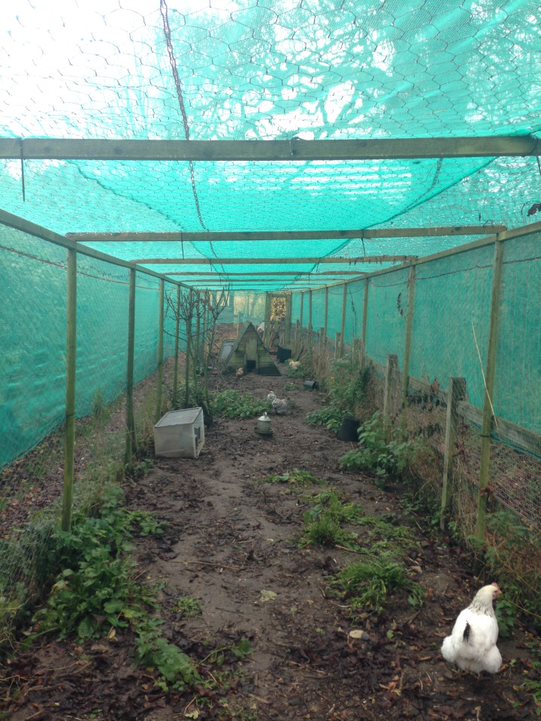Chicken facts
Chickens are the fourth most popular pet in the UK, and their numbers are increasing. They are popular as pets due to their incredible personality and the ability to provide us with eggs for breakfast! Our domestic chicken has come a long way from its predecessor, the red junglefowl, who historically reside in southeast Asia. Chickens now come in many different shapes and sizes. Here are just a few of the main types of chickens you may come across:
Hybrid
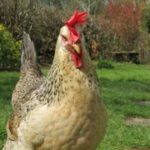
Probably the most popular backyard chicken to keep as a pet as they lay very well and come in a variety of colours and variations.
Bantam
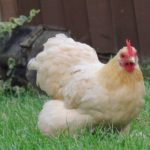
A miniature version of a specific breed of chicken – these do not lay well but make great pets as they are small and come in a variety of colours and shapes.
Purebred
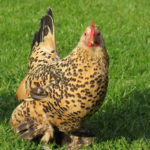
Otherwise known as fancy fowl, these birds are bred for their looks and are often shown or kept as novelty pets. Some breeds lay poorly while others lay very well. These are usually sourced direct from the breeder.
Ex-commercials
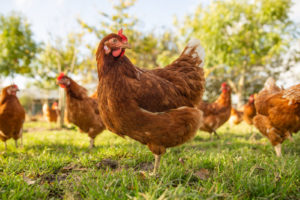
These will have been rehomed from a commercial set up (colony cage or free-range unit) at usually around 76-80 weeks of age. Although they require a fair bit of TLC to get used to life in a home environment, these birds make amazing pets, are fabulous layers and come fully vaccinated. These are usually brown/ginger in colour.
Most breeds of chicken start to lay eggs at 20-21 weeks old. The age range of 16-20 weeks of age is commonly known as the ‘point of lay’. Most people tend to buy a ‘point of lay’ hen as by this age you can easily identify the difference between a hen and cockerel. Young hens, otherwise known as pullets, do not have the pronounced red comb until they become sexually mature.
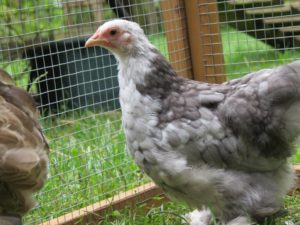 Pullet; Note lack of prominent comb.
Pullet; Note lack of prominent comb.
Housing
There are many different types of housing available for chickens. Most are made of either wood or plastic. When choosing your house it is important to take the following into consideration:
- If wooden make sure the wood is properly treated to withstand the weather.
- Avoid felt roofs, as these are a haven for red mite. A wooden or corrugated roof is a better choice.
- Ensure there are holes in the coop that can be opened to provide fresh air to the hens. Ideally these should be covered with mesh.
- Pop-holes and doors should be secure to keep out predators and at least 30 x 30cm in size.
- Perches should be removable to aid cleaning.
- One nest box for three hens.
- Runs can be made fox-proof by either having wire mesh extending beneath the ground (permanent run) or by having a skirt around the run (moveable run)
- Plastic houses tend to have a lower chance of a severe red mite infestation as they have fewer cracks and crevices for them to live. It is also easier to get rid of red mite by hosing out the coop.
- Partial shade is essential for the run to reduce the risk of heat stress in warmer weather
- Straw is a very good bedding material. Sawdust can also be used provided it is dust extracted. Hay should not be used as hens can eat this and be at risk of a gut impaction.
- Cleaning the coop once a week is plenty. If you have a mobile run this is also a good opportunity to move the run to rest the ground.
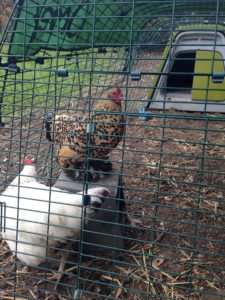 Plastic coops; easy to clean and disinfect and come in a variety of different sizes and styles.
Plastic coops; easy to clean and disinfect and come in a variety of different sizes and styles.
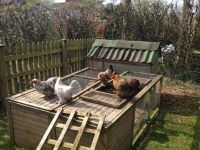
Wooden Coop
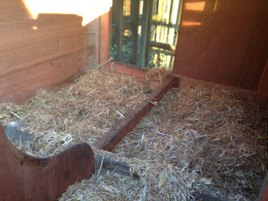
Inside coop; note perching and nest boxes.
Enrichment
Chickens are naturally very inquisitive animals, so providing enrichment gives both them and you plenty of entertainment!
The main way chickens investigate their environment is through pecking, so the most successful enrichment will encourage this behaviour. Chickens can get used to things in their environment, so ideally enrichment should be swapped every two weeks to keep them interested, you can always go back to a previous toy after they’ve had a break from it! Pecking toys can be combined with food treats to help encourage and stimulate the behaviour. Hanging fruit or vegetables from the top of the run can be a very good way to have treats last longer. Equally, an old plastic bottle filled with corn with holes made just large enough for the corn to fall through when pecked can be suspended in the run. Chickens can also be surprisingly entertained with treat balls, similar to what you might give a cat or dog.
Chickens also like to perch. Providing interesting perching spots will provide your chickens with great enrichment and help them feel safer.
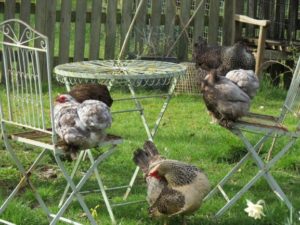
Feed
Most local feed shops and even some pet shops now stock a reputable laying hen pellet feed. These feeds are well designed to provide the nutrients and minerals that a laying chicken needs and as such should make up most your hens’ diet. It is important not to feed treats first thing in the morning; this means that, when the chickens are hungriest, they will first fill up on layers pellets.
It is okay to feed your chickens treats such as fruit, vegetables, seeds and even yoghurt. However, treats should always be given in moderation and it would be advisable to feed treats in the afternoon.
Behaviour
Chickens will naturally form a linear hierarchy, or pecking order, within their flock. The top hen will generally get first pick of any treats and will show dominant behaviour to any subordinate hens that get there first. Dominant behaviours shown by hens are pecking, typically aimed at the head and neck, and standing very upright. So long as these behaviours don’t get out of hand or result in injury of a lower ranking hen then they should not give cause for concern.
Due to the hierarchy hens form it is best to keep at least three hens together, so one hen isn’t constantly picked on by another. Similarly, when introducing new birds to an established flock, it is best to introduce at least two new birds. If you have a larger backyard flock or are having problems with your hens hierarchy, this can be managed by having a cockerel in your flock to help break up fights between hens.
Chickens will spend their days showing a variety of normal behaviours including foraging, scratching, dustbathing, preening and sunbathing. Providing chickens with the ability to exhibit these behaviours is paramount to their happiness.
Chickens can make a variety of vocalisations. Typically these will be the chunter and clucks commonly associated with chickens. Occasionally they will make much louder sounds, these are often one of two things:
- Alarm sounds, alerting the rest of the flock to a perceived danger such as a bird of prey.
- Or what is affectionately known as the ‘egg song’, the series of loud vocalisations a hen frequently makes after laying her egg.
If you have a cockerel in your flock you may also hear his vocalisations, alerting the hens to any treats he has found.
Chickens are animals of routine. Wherever possible you should stick to a broadly similar daily routine when caring for your hens.
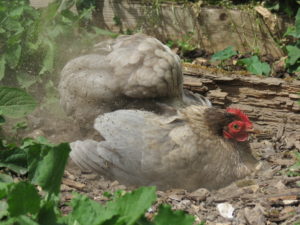
Dustbathing
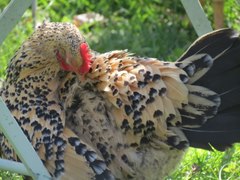
Preening
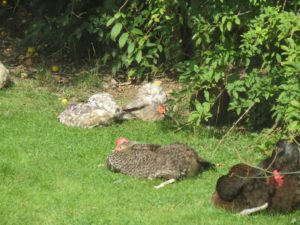
Sunbathing
Broody Hens
A broody hen is one who wants to incubate eggs. Some breeds are broody more often than others. For example pekins and silkies are very prone to being broody, whereas a hybrid hen is less so. A broody hen will often have a warm patch of featherless skin on her chest known as the brood patch, which helps her incubate eggs. Typically a broody hen will not leave the nest box and will often fluff up her feathers, peck and growl if attempts are made to remove her. If you wish to hatch eggs under a hen, it is best to place fertile eggs under her as soon as you notice she is broody. If you don’t wish to hatch eggs, it’s important to remove eggs from the nest box promptly to help break the behaviour. Regardless of whether she is incubating eggs, a broody hen should be removed from the next box twice a day to encourage her to eat and drink. Usually a broody period would not last more than three weeks, though some hens can be more persistent!
If you wish to break the behaviour sooner then you will need to separate the hen from the nest box and attempt to cool her down. The best way to achieve this is in a cage with a wire floor, raised off the ground to aid air circulation, though the floor mesh should not be so large that her feet can fall through the mesh. Ensure she has plenty of food and water in the cage with her. If the weather is warmer, you could also place her in a bowl of cold water and then leave her to dry off.
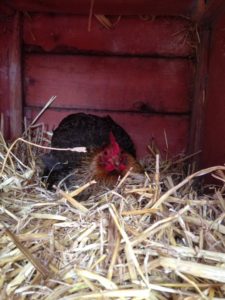
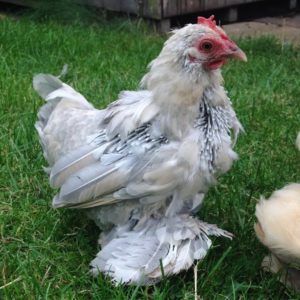
Moulting
Once per year, most hens go through a period of moult. This is entirely normal. The birds will shed their feather and grow in new ones, during this time they may cease laying.
Avian Influenza/ Flu
With the ongoing risk of avian influenza, it is recommended investing some time and money to create a range area that it entirely under cover. Ensuring feed and drinkers are in areas that wild birds cannot access will decrease the risk to your own birds as well as fulfilling the requirements for housing orders.
